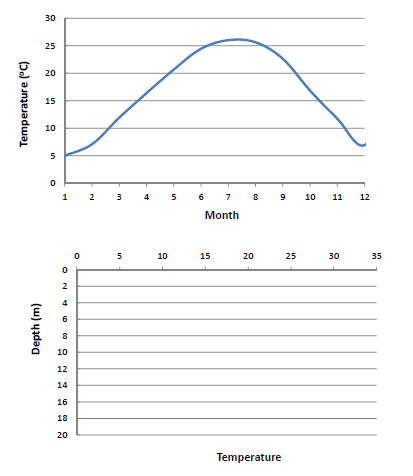Reference no: EM1342099
Environmental engineering
Question 1: Although it is rarely considered as such, sulfur could potentially be a limiting nutrient in some aquatic systems.
a) If a lake contains 1.1 mg/L NH3-N, 0.20 mg/L PO4-P, and 0.03 mg/L SO4-S, and if the average composition of an algal cell can be represented as C106H181O45N16P1S0.1, determine which nutrient is likely to be growth limiting, and what the maximum amount of algal growth (mg algae/L) could be.
b) It is proposed to limit algal growth to one-half of its initial maximum potential by addition of FeCl3. The FeCl3 dissolves and completely dissociates into Fe3+ and Cl- ions. The Fe3+ ions do not react with N- or S-containing compounds, but they do react with PO43- to form very insoluble precipitates of FePO4(s). These solids are so insoluble that it is reasonable to assume that every atom of Fe3+ entering the solution precipitates as FePO4(s) until essentially all the TOTPO4 has been removed from solution. How much FeCl3 (mg/L) must be added to achieve the treatment goal?
Question 2: Consider a 20-m-deep lake in Georgia, where the average local air temperature during the year is shown below. When the lake is stratified, the thermocline begins at a depth of 4 m. Draw a reasonable sketch on the graph of the monthly average water temperature in the top few meters of the lake. Based on your sketch, identify the approximate periods when the lake is well mixed and when it is stratified. Based on your sketch of the water temperature, give approximate date(s) when the lake turns over. On the second graph, sketch profiles of temperature versus depth in the lake on 15 January, May, and September.

Question 3: Wastewater is being treated in two well-mixed ponds in series. The flow rate of the wastewater is 4000 m3/d, and the ponds each have volumes of 20,000 m3 and 12,000 m3, respectively. The influent to the first pond has an ultimate BOD (i.e., L0) of 200 mg/L, and the system has been operating long enough to reach steady-state.
(a) If kd is 0.35 d-1 in each pond, how much BOD remains in the effluent as the water exits the second pond?
(b) The untreated wastewater is devoid of DO, the water in both ponds is at 20oC, and the DO concentration must be maintained at 1.0 mg/L or greater to support the aerobic microbes that are carrying out the biodegradation process. The ponds will be aerated mechanically in order to supply the needed oxygen. What is the minimum reaeration rate constant (kr) that the aerators must provide in each pond to assure that the process will work properly?
Question 4: Lakes often stratify into two distinct layers during both the summer and the winter months. Consider a situation in which a waste stream flows into a lake that is well-mixed during the early autumn but stratifies on November 1. After the lake stratifies, the river mixes only with the upper layer, which comprises 30% of the total lake volume. The river flow is 50 m3/min, and the lake volume is 4 x 106 m3. On November 1, the conditions are as follows:
BOD5 of the river 1.1 day upstream of the lake, based on incubation in the lab: 16 mg/L
BOD5 of the river at the inlet to the lake, based on incubation in the lab: 12 mg/L DO in the lake: 4.0 mg/L
The ultimate BOD at the upstream point (1.1 days upstream of the inlet to the lake) is the same year-round. The rate constant for BOD utilization in the lab is kd,lab = 0.30 d−1. Note that, although the organics degrade more rapidly in the lab than in the river, the ultimate BOD of a given sample is expected to be independent of the incubation conditions.
The river and lake systems are at steady-state before stratification, and the epilimnion of the lake reaches a new steady-state condition during the winter.
(a) Find the ultimate BOD of the river water as it enters the lake.
(b) Find the value of the rate constant for BOD utilization in the river, kd,riv.
(c) Assuming that kd,lake = kd,riv and that these values are constant throughout the period of winter stratification, find the ultimate BOD in the epilimnion when it reaches steady-state in mid-winter.
(d) Assuming that kd in the river and the lake during the spring and summer is twice the value in the winter, find the ultimate BOD in the epilimnion when it reaches steady-state in summer.
(e) What would the value of the reiteration constant have to be during each period of stratification to maintain a steady state DO of 3.0 mg/L in the epiliminion? Assume that DOs is 13 mg/L in the winter and 9 mg/L in the summer.
(f) Would you expect the hypolimnion to become anaerobic in the winter? If so, approximately how long after stratification with this occur? If not, what would be the ultimate BOD of the hypolimnion at the time of the spring turnover (March 1)?